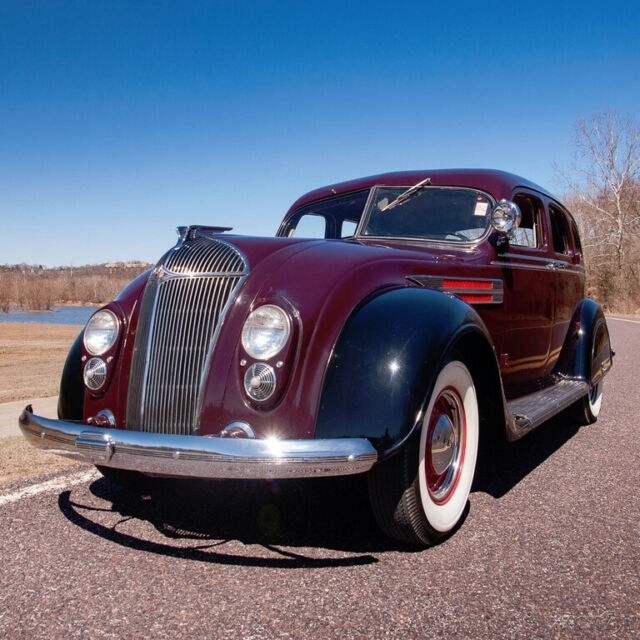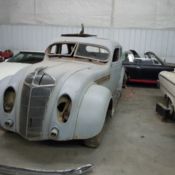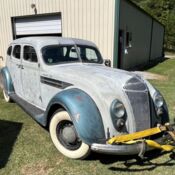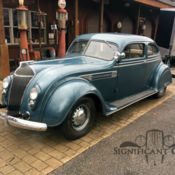1936 Chrysler Airflow C-9 Sedan
1936 Chrysler Airflow C-9 Sedan
1936 Chrysler Airflow C-9 Sedan
Recently acquired from a long term collector from Sandy UtahOne of only 1,590 Chrysler Airflows C-9 Sedans made in 1936324 CID inline eight-cylinder engine with downdraft carburetorThree-speed manual transmission with automatic overdrive with semi-floating rear axleHarvard Maroon over black exterior with tan broadcloth interiorUni-body construction, all-steel top and 123-inch wheelbaseSix-way adjustable front seat, hydraulic power-assisted brakesAutomatic electric choke, "Floating Power" engine mounts and "Life Guard" inner tubesCrank-out windshield, recent MOPAR spotlightDocumentation includes poster of vehicle statisticsLooking for all the world like it belongs on the set of a Dick Tracy film, Chrysler went out on a rare limb in the mid-1930s and unveiled its Airflow models as the country recovered from the Great Depression. Rarely seen today, this example is just one of 1,590 Chrysler Airflows C-9 made at Chrysler's Highland Park, Michigan assembly plant in 1936 and now it is for sale at MotoeXotica Classic Cars. We recently acquired this Airflow from a well known long-term collector from Sandy Utah.
Dressed in Harvard Maroon over black, the car's paint and trim are in overall very good order and even add a slight sinister air to the car's presence. The car's vee'd, two-piece windshield (which could be opened via hand crank), six side windows and divided rear glass are all clear and intact while the aerodynamic headlights and accented taillights enhance the car's avant-garde styling. The front side vent windows even roll into the doors with the main glass, however there is a crack in the driver's side rearmost window. As was common during that time, the rear doors open "coach" style, i.e., they are hinged at the rear (suicide).
With solid, original bodywork, including an all-steel top, the car's engine bay is quite tidy, its cargo area with a full-sized spare tire, is in very good order and the car's chrome bumpers are in very good, original condition. This Airflow rides on wide whitewall tires, size 7.00-16 at all four corners. Airflows in 1936 featured "Life Guard" inner tubes which had dual inner tubes. Each tire is mounted to red, vented factory wheel with a steel center cap. The tires and wheels are in good, original condition. Note that this car only has a working driver's side windshield wiper and a modern, Mopar driver's side spotlight.
Under the hood is Chrysler's 324 CID straight eight-cylinder engine with downdraft carburetor. Backing this motor are a three-speed manual transmission with automatic overdrive and a semi-floating rear axle with a 4.1:1 rear end. Driver convenience features include power-assisted hydraulic brakes, automatic electric choke and "Floating Power" engine mounts.
Inside, the tan broadcloth interior is in overall great shape. The large, accommodating front and rear seats look comfy enough to fall asleep in. The front seat even has six-way adjustments. The matching carpet and headliner also are in very good shape. A black, three-spoke steering wheel faces the driver while the instrument panel, with its Art Deco design, center-mounted gauges, speedometer and tachometer combination and woodgrain accents, is in very good order, as are the inner door panels. In back, a long metal bar hangs from the rear of the front bench so one could hang overcoats or blankets on during winter or other, cold periods. The rear window also came with a roll-down sunshade.
The first thing prospective customers noticed about the Airflow was its conspicuously modern styling compared to other "two-box" and more traditional cars in the mid-1930s. Carl Breer, who led Chrysler's Research and Development Group, realized that traditional automotive bodies were ill-equipped to handle speeds in excess of 80 miles per hour, top velocities becoming more common during this era.
Using small-scale and life-sized wind tunnels, Breer and his team discovered that some cars exhibited less drag going backward so Chrysler stylists gave the car a tapered rear end with a curved front. Designers moved the passenger cabin forward, reducing vibrations and moving rear seat passengers from sitting over the rear axle. Pushing the four wheels to the cars' ends vastly enhanced the car's cornering and ride, 60 years prior to the company's "Cab Forward" designs. As a widely distributed promotional reel shown in movie theatres, audiences nationwide watched an empty Airflow tumble down a 110-foot tall cliff in Pennsylvania, followed by someone who gets in and drive the damaged car away under its own power.
Chrysler also changed things most customers never saw. A semi-unit-body frame replaced the ubiquitous ladder frame. The Airflow's body was stiffer than comparable body-on-frame cars. Besides moving the cabin forward, the Airflow engines rested over the front axles, the rear seat set 20 inches forward of the rear axle, putting driver and passengers between the axles. This also allowed the front and rear suspensions to operate independently. Chrysler engineers also created the cars' "Floating Ride, "? which had spring actions people found natural and restful.
For 1936, the Airflow surrendered its smooth backside when a trunk was tacked onto the body of the car. The grille also became more pronounced. That year, only the C-9 and C-10 Airflow body styles broke the 1,000-unit mark. Otherwise, total Airflow production sank to 6,275 units compared to the concurrent Airstream models, which sold more than 52,000 units for 1936. Nineteen thirty-six would be the last year that Chrysler's premium Imperial model range would carry the Airflow. Life Guard tires were introduced, which had two tubes inside the tire.
Prospective customers gave the Airflow the cold shoulder, sales-wise. Some people derided it as too ugly, others found it to be too radical to put one in their driveway or on in front of their home. Chrysler made some attempts to change trim and minor styling pieces from 1935 to 1937 but the basic shape remained. The Airflow damaged Chrysler far more than one would think; the company lost market share, time and credibility forcing Chrysler to become overcautious in its products for 30 years, and, erasing, to a degree, its main strength; and styling became more important. The key technical lessons of the Airflow would be put aside — though some were picked up outside the company.
General Motors responded to the Airflow with its Turret Top models. Volvo and Peugeot quickly copied and condensed the Airflow's styling and advantages for themselves. Volvo released the PV 36 Carioca between 1935 and 1938 while the Peugeot 202 was built between 1938 and 1942 and after a stint of 20 models in 1945, it continued from 1946 until 1949. The Airflow's biggest imitator may have been a new car company called Toyota with its first production model, the AA in 1936.
Competition to this Airflow in 1936 included Buick's Century, Cadillac's Series 60 sedan, Chrysler's Airstream, DeSoto's companion Airflow and Airstream, Dodge's D2 four-door touring sedan, LaSalle's Series 50, the Lincoln-Zephyr sedan, Oldsmobile's Series L, Packard's One-Twenty Sedan and Pontiac's DeLuxe Eight.
The Airflow is an American classic, a 1930s styling icon and it directly or indirectly influenced automakers worldwide. You probably would not see another one like it at a local car show or cruise event but you would field a lot of questions from curious passers-by and maybe even hear a few stories from those whose parents or grandparents used to own an Airflow. If you're interested in getting your hands on this rolling, Art Deco masterpiece, you should visit MotoeXotica Classic Cars today!
Body#: 6607444Engine#: C-9-2352
This car is currently located at our facility in St. Louis, Missouri. Current mileage on the odometer shows 83,625 miles. It is sold as is, where is, on a clean and clear, mileage exempt title. GET OUT AND DRIVE!!!
Note: Please see full terms and conditions listed below that pertain to the purchase of any said vehicle, thank you.
Please Copy & Paste the Link Below to View Our YouTube Video:
https://youtu.be/Gdrn5IDRiys
- Make: Chrysler
- Model: Airflow C-9
- SubModel: Airflow C-9 Sedan
- Type: Sedan
- Trim: Sedan
- Doors: 4 Doors
- Year: 1936
- Mileage: 83625
- VIN: 6607444
- Color: Other Color
- Engine size: 324 CID Straight Eight
- Number of cylinders: 8
- Transmission: Automatic
- Drive type: RWD
- Interior color: Tan
- Vehicle Title: Clear Want to buy? Contact seller!






















